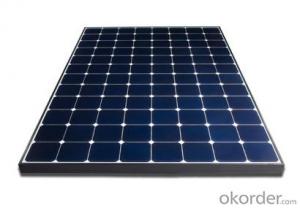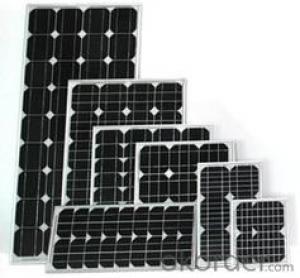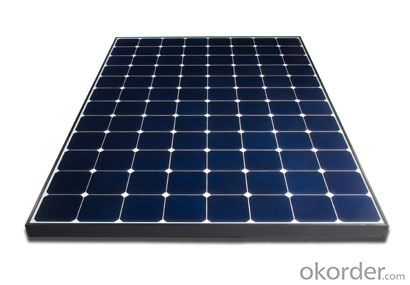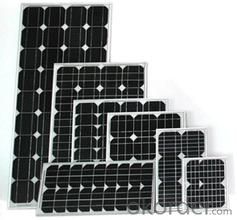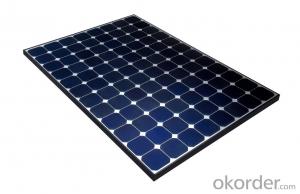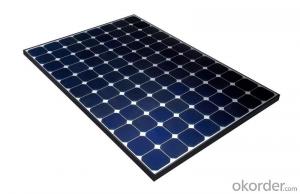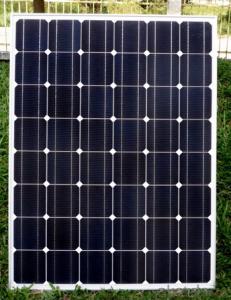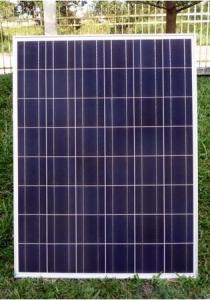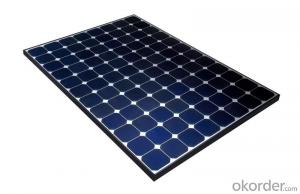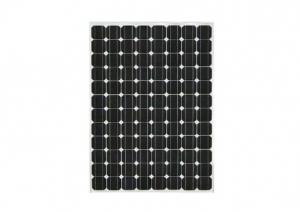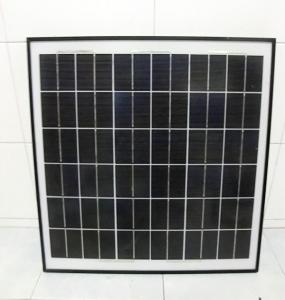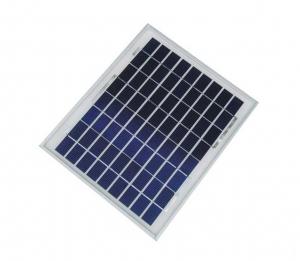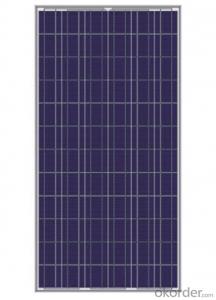CNBM Poly 410W Solar Panel with TUV UL CE Certificate for Residential
- Loading Port:
- Shanghai
- Payment Terms:
- TT OR LC
- Min Order Qty:
- 100 watt
- Supply Capability:
- 1000 watt/month
OKorder Service Pledge
OKorder Financial Service
You Might Also Like
Specification
CNBM Poly 210W Solar Panel with TUV UL CE Certificate For Residential
Introduction
Electrical connections are made in series to achieve a desired output voltage and/or in parallel to provide a desired current capability. The conducting wires that take the current off the modules may contain silver, copper or other non-magnetic conductive [transition metals]. The cells must be connected electrically to one another and to the rest of the system. Externally, popular terrestrial usage photovoltaic modules use MC3 (older) or MC4 connectors to facilitate easy weatherproof connections to the rest of the system.
A single solar module can produce only a limited amount of power; most installations contain multiple modules. A photovoltaic system typically includes a panel or an array of solar modules, a solar inverter, and sometimes a battery and/or solar tracker and interconnection wiring.
Micro-inverted solar panels are wired in parallel which produces more output than normal panels which are wired in series with the output of the series determined by the lowest performing panel (this is known as the "Christmas light effect"). Micro-inverters work independently so each panel contributes its maximum possible output given the available sunlight.[6
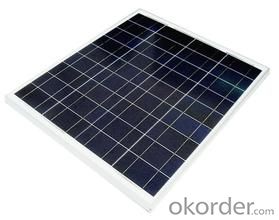
Suggested application
Home lighting business lighting,
Garden lighting, pavement lighting
Farmer household lighting
Decorative water pump
Traffic signal lighting
Industry area
Business area
Solar Power Plant
Product feature
Modules are made of Monocrystalline or Polycrystalline Silicon cell.
Materials and color of the solar panel frame: Clear anodized aluminum alloy type 6063T5 Universal frame; Silver-white color;
The output connection gathers the coupling: Selects conforms to the IEC-612615; 2005, class II, IEC61730 international standard; Airtight waterproofing binding clamp;
Module seal structure: The surface is thick, the high diaphanous rate armored glass with solar cell board special-purpose 3.2mm becomes after the high temperature lamination craft. The back selects has waterproof and anti- aged performance fine TPT materials. The entire block battery board has, the waterproofing, the anti- aging airtight and so on the fine performance;
Power tolerance: +/-3%
Packaging
International standard cartons (according to the requirements of customers)
- Q: I've been looking into solar panels. They are fairly expensive ($35k or so). My state has some rebates and grants available. Is anyone aware of any federal grants and rebates other than the federal tax credit? We are subject to AMT tax and can't take the credit. (Which is ridiculous, is the federal government committed to conservation or aren't they??????)
- I have some panels on my house and no they are not cheap. If you look around you can buy them for around $4.70 per watt for a 00 plus watt panel, this will make them $470 or more. But you will get a first quality panel. And no I do not know of any fed. government programs for home owners. These kind of programs usually only go to large companies. And it does not look like our government is going to help seeing how the let the large oil companies keep there tax programs but refused to help solar. This just happened today when the senate voted on the energy plane. Good luck go solar
- Q: Can solar panels be used to power air conditioning units?
- Yes, solar panels can be used to power air conditioning units. Solar panels generate electricity from sunlight, which can be used to power various appliances, including air conditioning units. This is an eco-friendly and cost-effective way to cool buildings and reduce reliance on traditional energy sources.
- Q: Are solar panels durable?
- Yes, solar panels are durable. They are designed to withstand various weather conditions, including rain, snow, and wind. Additionally, most solar panels come with a warranty of 25 to 30 years, indicating their long lifespan and ability to withstand wear and tear over time.
- Q: My project needs to build a thermal solar panel that would be used as a demonstrational rig. The dimensions i am allowed do not allow me to use a normal thermal solar panel so i have decided to use the heat exchanger from the back of a fridge. Although this is possible to use what equation would i use to prove the power of the sun would actually heat up the water. More importantly when the rig is demonstrated to students, they will need to be able to determine if the raise in temperature given by the thermometers is what should be given. Variables of the rig will include: Angle of the panel, Light intensity, Direction of panel, and more importantly the flow rate of the water travelling through the pipes. What equation includes those variables (change in temperature, flow rate) and would allow me to incorporate the angle of the panel. The light source would be a lamp so i would also need to know how much of the energy from the lamp is actually being used by the panel?
- Forget the long winded discussion above. There are so many variables that you cannot calculate the outcome. This does not mean that the experiment is a failure. It gives you information on the fact that water can be heated in this manner, and that you can vary the result by modifying the variables.
- Q: Can solar panels be installed on wearable devices?
- Yes, solar panels can be installed on wearable devices, but their effectiveness may be limited due to the small surface area available for solar absorption. Additionally, the amount of energy generated may not be sufficient to power the wearable device continuously. However, advancements in solar technology may make it more feasible and efficient in the future.
- Q: Main questions: How can I work out the efficiency of a solar panel and how can I work out if the panel is relatively cost-effective? Also what type of solar panels is considered most effiecient?Let's assume that all relative values are available.Secondary question: What type of safety regulations and licenses are required to be fulfiled in order to import solar panels into the EU from non-EU countries?
- Guide okorder /
- Q: Can solar panels be installed on historic buildings?
- Yes, solar panels can be installed on historic buildings. However, the installation process needs to be carefully planned and executed to ensure that it does not damage the historic fabric or compromise the architectural integrity of the building.
- Q: Can someone tell me the average savings you get PER solar panel installed? I do not have the money to invest in a bunch of them at once, so I am forced to buy one at a time, when I have the money. So how much can I expect to save after I buy the first one?
- No matter what or how you do it it is best to get off coal and nukes. So it cost a little bit of money you are buying 30 years of electric. How much will you spend adding in cost of living increases over the next 30 years? Solar really is pretty cheap if you take the time to do the long term math. If you use your cost at to days rates it does seem like a lot. But if you do the math like in real life with 3.5% compounded cost of living increases per year and 6.5% fuel increases per year. Well, you pay a lot more renting power. One other thing to think about and Al Gore keeps pointing it out is, Will your off spring be alive in 50 years from now if you don't buy the solar panel? Kind of like not going to the doctor because you can't afford the bill. Well I would rather owe a bill to a doctor that I will have trouble paying then not be alive at all to try. If you don't have the money to jump in and go full blown Green you should buy a starter system. You can get a system that can be expanded to 3000 watts (enough to power an energy efficient home). Would cost you about $8000 USD to get started and then you could add three solar modules at a time till you get it up to the 3000 watt max. And even have backup power. Or you could just buy a 000 watt system for about the same price and just add 3 of them over the years. There are many ways to get started. The deal is everyone needs to get started even if it is a small system. If all 50 million homes in the USA would install a small 000 watt system with 4 hours of sun light a day. We would provide (000 watts times 4 hours times 365 days times 50 million homes) 29,000,000,000,000 watts not from coal or nuke plants per year. I wonder if that would help?
- Q: Can solar panels be used on vehicles?
- Yes, solar panels can be used on vehicles. They can be installed on the roof or the body of the vehicle to harness sunlight and convert it into electrical energy, which can be used to power various systems or charge the vehicle's battery. This technology is commonly used in electric and hybrid vehicles to improve their energy efficiency and reduce their carbon footprint.
Send your message to us
CNBM Poly 410W Solar Panel with TUV UL CE Certificate for Residential
- Loading Port:
- Shanghai
- Payment Terms:
- TT OR LC
- Min Order Qty:
- 100 watt
- Supply Capability:
- 1000 watt/month
OKorder Service Pledge
OKorder Financial Service
Similar products
Hot products
Hot Searches
